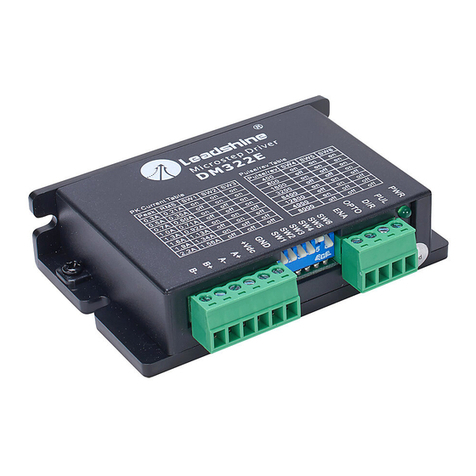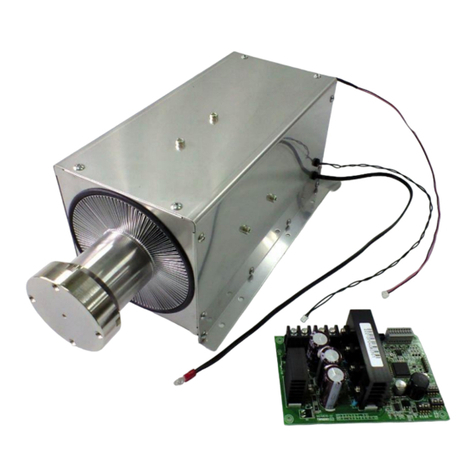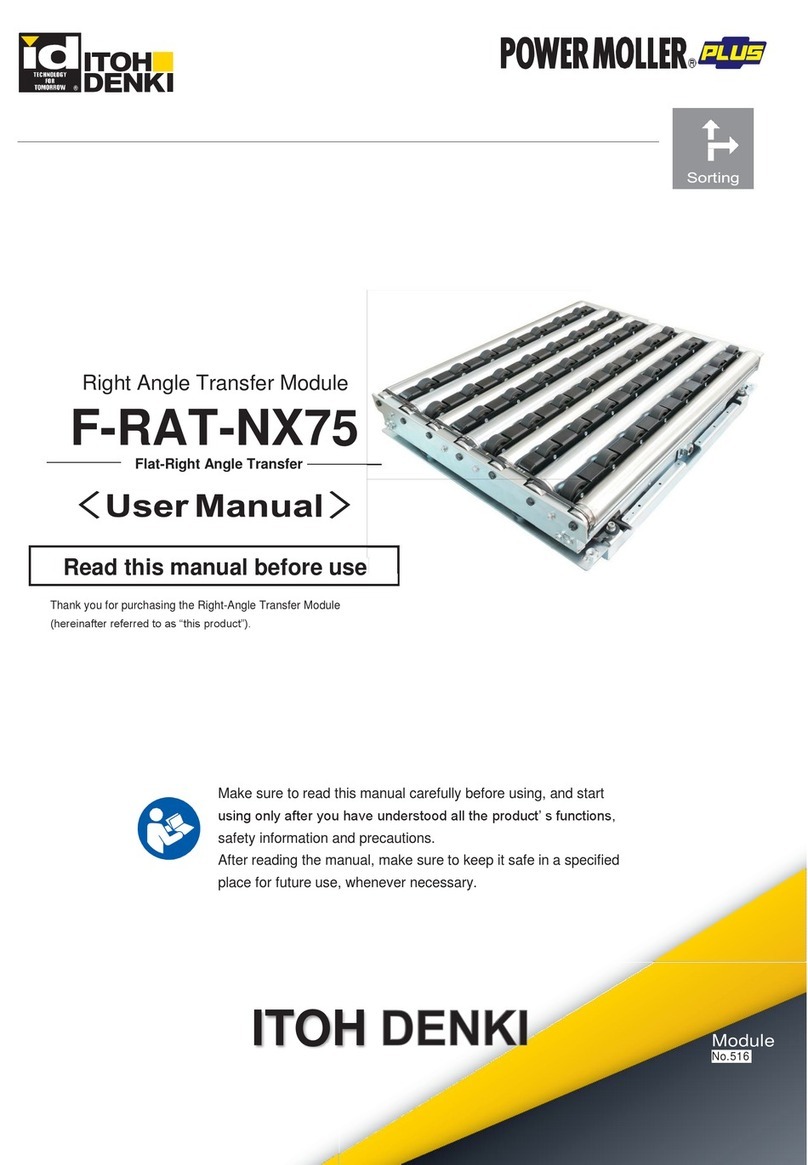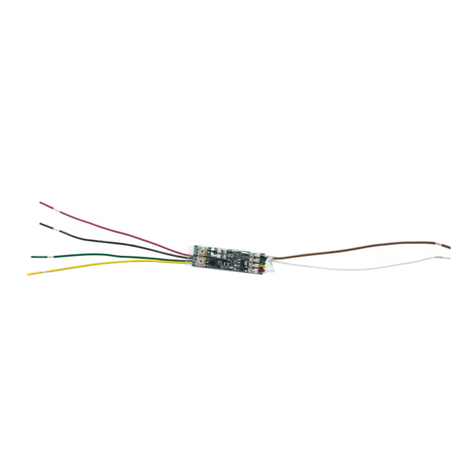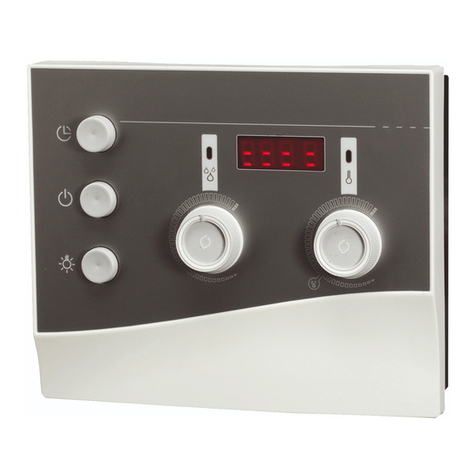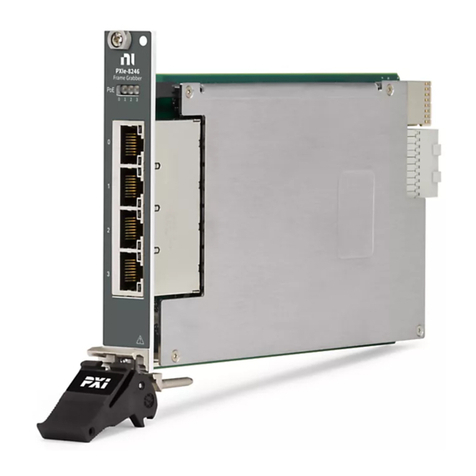Cross Technologies 1586-04-0431 User manual

Instruction Manual Model 1586-04-0431
RF Attenuator
April 2021, Rev 0
MENU
EXECUTE
MODEL 1586
CROSS TECHNOLOGIES INC.
G1=-33.0 G2=-41.0
G3=-17.0 G4=-52.0
REMOTE
ALARM
POWER
RF ATTENUATOR
Data, drawings, and other material contained herein are proprietary to Cross Technologies, Inc.,
but may be reproduced or duplicated without the prior permission of Cross Technologies, Inc.
for purposes of operating the equipment.
When ordering parts from Cross Technologies, Inc., be sure to include the equipment
model number, equipment serial number, and a description of the part.
CROSS TECHNOLOGIES, INC.
6170 Shiloh Road
Alpharetta, Georgia 30005
(770) 886-8005
FAX (770) 886-7964
Toll Free 888-900-5588
WEB www.crosstechnologies.com
E-MAIL [email protected]

INSTRUCTION MANUAL
MODEL 1586-06 RF Attenuator
TABLE OF CONTENTS PAGE
Warranty 2
1.0 General 3
1.1 Equipment Description 3
1.2 Technical Characteristics 4
1.3 Monitor & Control Interface 5
2.0 Installation 10
2.1 Mechanical 10
2.2 Rear I/O’s 11
2.3 Front Panel Controls, Indicators 11
2.4 Operation 12
2.5 Menu Settings 13
2.6 Environmental Use Information 17
WARRANTY - The following warranty applies to all Cross Technologies, Inc. products.
All Cross Technologies, Inc. products are warranted against defective materials and
workmanship for a period of one year after shipment to customer. Cross Technologies,
Inc.’s obligation under this warranty is limited to repairing or, at Cross Technologies, Inc.’s
option, replacing parts, subassemblies, or entire assemblies. Cross Technologies, Inc. shall
not be liable for any special, indirect, or consequential damages. This warranty does not
cover parts or equipment which have been subject to misuse, negligence, or accident by the
customer during use. All shipping costs for warranty repairs will be prepaid by the
customer. There are no other warranties, express or implied, except as stated herein.
CROSS TECHNOLOGIES, INC.
6170 Shiloh Road
Alpharetta, Georgia 30005
(770) 886-8005
FAX (770) 886-7964
Toll Free 888-900-5588
WEB www.crosstechnologies.com
E-MAIL [email protected]
1586-04-0431 Manual Page 2 4/12/21

MODEL 1586-04-0431 RF Attenuator
1.0 General
1.1 Equipment Description - The 1586-04-0431 Programmable Attenuator contains two 0.5 to 4 GHz and two
25 to 31 GHz Digital PIN Attenuators and Local/Remote control circuitry to independently adjust each
attenuator. Multi-function push button switches select the attenuation locally. The attenuator values are stored
in nonvolatile memory so these values remain when power is cycled off and on. Front panel LEDs provide
indication of DC power (green), Alarm (red), and Remote (yellow). Each Attenuator provides an attenuation
range of 60 dB from 10 to 70 dB attenuation. Remote operation also controls each attenuator, provides status
monitoring of attenuator settings, power supply, and summary alarms. Attenuator settings appear on the LCD
display. An “Offset” command allows adding an external attenuator to shift the attenuation range by the
amount of the attenuator with the total attenuation shown on the display and via the M&C. Connectors
are SMA, female (CH1, CH2) or 2.92 mm (CH3, CH4) for inputs and outputs and DB9 female for the RS422
remote control (Ethernet Optional). It is powered by a 100-240 ±10% VAC power supply (Option -R for
redundant supplies), and in a 1 3/4” X 19 “ X 16” rack mount chassis.
MENU
EXECUTE
MODEL 1586
CROSS TECHNOLOGIES INC.
G1=-33.0 G2=-41.0
G3=-17.0 G4=-52.0
REMOTE
ALARM
POWER
RF ATTENUATOR
FRONT PANEL
AC
GND
RF IN -1
RF OUT-2
J10
AND
MONITOR
CONTROL
J20
1
5
2
3
4
6
7
8
9
RF IN -2
RF OUT-1
J102
J103
RF IN -3
RF OUT-4
RF IN -4
RF OUT-3
J106
J107
J101
J104
J105
J108
REAR PANEL
FIGURE 1.1 Model 1586-04-0431 RF Attenuator Front and Rear Panels
CHANNEL 1, 2
0.1 to 4.0 GHz
1586-04-0431 Attenuator
Block Diagram
0.5 to 4.0
GHz
CH1, CH2
OUT
0.5 to 4.0 GHz
CH1, CH2 IN
M&C
ATT CONTROL
CONTROLLER
V
A
R
A
T
T
25 to 31 GHz
CH3, CH4
OUT
25 to 31 GHz
CH3, CH4 IN
V
A
R
A
T
T
CHANNEL 3, 4
25 to 31 GHz
A
T
T
A
T
T
A
T
T
FIGURE 1.2 Model 1586-04-0431 RF Attenuator Block Diagrams
1586-04-0431 Manual Page 3 4/12/21

1.2 Technical Characteristics
TABLE 1.1 Model 1586-04-0431 RF Attenuator Technical Characteristics
EQUIPMENT SPECIFICATIONS*
EQUIPMENT SPECIFICATIONS*
Input Characteristics
Input Characteristics
CH 1,2
CH 3,4
Impedance/Return Loss
50Ω/14 dB
50Ω/14 dB
Frequency
0.5-4.0 GHz
25.0-31.0 GHz
Input No Damage
+20 dBm
+20 dBm
Input Level range
0 to -20 dBm
0 to -20 dBm
Input 1 dB comp, min att
+10 dBm
+10 dBm
Output Characteristics
Output Characteristics
Impedance/Return Loss
50 Ω/14 dB
50 Ω/14 dB
Frequency (GHz)
0.5-4.0 GHz
25.0-31.0 GHz
Output Level Range
-20 to -80 dBm
-20 to -80 dBm
Channel Characteristics
Channel Characteristics
Channel Characteristics
Attenuation, min."at Fc
10 ±1 dB
10 ±1 dB
Att. range, 0.5±0.5 dB steps
10 to 70 dB
10 to 70 dB
Freq. Resp. @att range
10 to 30 dB
±1.5 dB
±1.5 dB
31 to 50 dB
±2.0 dB
±2.0 dB
51 to 70 dB
±2.5 dB
±2.5 dB
Att Accuracy @att range, Fc
Att Accuracy @att range, Fc
10 to 30 dB
±1.0 dB
±1.0 dB
31 to 50 dB
±1.0 dB
±1.0 dB
51 to 70 dB
±1.5 dB
±1.5 dB
Other
Temp Coefficient ±0.025 dB/Degree C, max.
Controls, Indicators
Gain Direct readout LCD; pushbutton switches or remote
Offset Shifts attenuation range by the amount of ext attenuator
Power; Alarm; Remote Green LED; Red LED; Yellow LED
Remote RS232C/RS485/422, 9600 baud (Ethernet Optional)
Other
CH 1,2; CH 3,4 Con. SMA (female); 2.92 mm (female), 50Ω
Alarm Connector DB9 - NO or NC contact closure on Alarm
Size 19 inch standard chassis 1.75” high X 19” deep
Power 100-240 ± 10% VAC, 47 - 63 Hz, 25 watts maximum
*+10 to +40 degrees C; Specifications subject to change without notice
1586-04-0431 Manual Page 4 4/12/21

1.3 Monitor and Control Interface
A) Remote serial interface
Protocol: RS-232C, 9600 baud rate, no parity, 8 data bits, 1 start bit, and 1 stop bit.
(RS-232C, RS-422, or RS-485)
1
2
3
4
5
6
7
8
9
1
2
3
4
5
6
7
8
9
Female DB-9
PC Com Port
Male DB-9
1586-04-0431 M&C Port
M&C Cable Diagram - Cross Technologies Frequency Converters
RX
RX
TX
TX
DTR
SG
DSR
RTS
CTS
SG
Connector: Rear panel, DB-9 male
J10 Pinouts (RS-232C/422/485)
J10 Pinouts (RS-232C/422/485)
Pin Function
1 Rx-
2 Rx+ (RS-232C)
3 Tx+ (RS-232C)
4Tx-
5GND
6 Alarm Relay: Common
7 Alarm Relay: Normally Open
8 Not Used
9 Alarm Relay: Normally Closed
1586-04-0431 Manual Page 5 4/12/21

B) Status Requests -
Table 1.1 lists the M&C commands for the 1586-04-0431 and briefly describes them.
*PLEASE NOTE: The two character {aa}(00-31) prefix, in the table below,
should be used ONLY when RS-485 is selected.
TABLE 1.1 1586-04-0431 Commands
TABLE 1.1 1586-04-0431 Commands
TABLE 1.1 1586-04-0431 Commands
Command Syntax *Description
Set Channel 1 Gain {aaCAyyyy} where:
aa = unit address, range = 00 to 31, only used if interface is RS485, otherwise omit
A = command code (case sensitive, capital A)
yyyy = Channel gain in dB.
Range: channel 1 offset -10.0 to channel 1 offset -70.0 in 0.5 dB steps; the decimal
point is optional.
example: {CA-455}
Will set channel 1 total gain (including offset) to -45.5 dB.
The unit will reply with the '>' character if the command is sucessfully processed.
Set Channel 1 Offset {aaCayy} where:
aa = unit address, range = 00 to 31, only used if interface is RS485, otherwise omit
a = command code (case sensitive, lower case a)
yy = Channel offset in dB. This value reflects any external attenuation added to
the system.
Range: 00 to 60 dB.
example: {Ca40}
Will set channel 1 external attenuation offset to 40 dB.
The unit will reply with the '>' character if the command is sucessfully processed.
Set Channel 2 Gain {aaCByyyy} where:
aa = unit address, range = 00 to 31, only used if interface is RS485, otherwise omit
B = command code (case sensitive, capital B)
yyyy = Channel gain in dB.
Range: channel 2 offset -10.0 to channel 2 offset -70.0 in 0.5 dB steps; the decimal
point is optional.
example: {CB455}
Will set channel 2 total gain (including offset) to -45.5 dB.
The unit will reply with the '>' character if the command is sucessfully processed.
Set Channel 2 Offset {aaCbyy} where:
aa = unit address, range = 00 to 31, only used if interface is RS485, otherwise omit
b = command code (case sensitive, lower case b)
yy = Channel offset in dB. This value reflects any external attenuation added to
the system.
Range: 00 to 60 dB.
example: {Cb40}
Will set channel 2 external attenuation offset to 40 dB.
The unit will reply with the '>' character if the command is sucessfully processed.
1586-04-0431 Manual Page 6 4/12/21

TABLE 1.1 Continued: 1586-04-0431 Commands
TABLE 1.1 Continued: 1586-04-0431 Commands
TABLE 1.1 Continued: 1586-04-0431 Commands
Command Syntax *Description
Set Channel 3 Gain {aaCCyyyy} where:
aa = unit address, range = 00 to 31, only used if interface is RS485, otherwise omit
C = command code (case sensitive, capital C)
yyyy = Channel gain in dB.
Range: channel 3 offset -10.0 to channel 3 offset -70.0 in 0.5 dB steps; the decimal
point is optional.
example: {CC-455}
Will set channel 1 total gain (including offset) to -45.5 dB.
The unit will reply with the '>' character if the command is sucessfully processed.
Set Channel 3 Offset {aaCcyy} where:
aa = unit address, range = 00 to 31, only used if interface is RS485, otherwise omit
c = command code (case sensitive, lower case c)
yy = Channel offset in dB. This value reflects any external attenuation added to
the system.
Range: 00 to 60 dB.
example: {Cc40}
Will set channel 3 external attenuation offset to 40 dB.
The unit will reply with the '>' character if the command is sucessfully processed.
Set Channel 4 Gain {aaCDyyyy} where:
aa = unit address, range = 00 to 31, only used if interface is RS485, otherwise omit
D = command code (case sensitive, capital D)
yyyy = Channel gain in dB.
Range: channel 4 offset -10.0 to channel 4 offset -70.0 in 0.5 dB steps; the decimal
point is optional.
example: {CD455}
Will set channel 4 total gain (including offset) to -45.5 dB.
The unit will reply with the '>' character if the command is sucessfully processed.
Set Channel 4 Offset {aaCdyy} where:
aa = unit address, range = 00 to 31, only used if interface is RS485, otherwise omit
d = command code (case sensitive, lower case d)
yy = Channel offset in dB. This value reflects any external attenuation added to
the system.
Range: 00 to 60 dB.
1586-04-0431 Manual Page 7 4/12/21

B) Status Requests -
Table 1.2 lists the status requests for the 1586-04-0431 and briefly describes them.
*PLEASE NOTE: The two character {aa}(00-31) prefix, in the table below,
should be used ONLY when RS-485, (OPTION-Q), is selected.
TABLE 1.2 1586-0400431 Status Requests
TABLE 1.2 1586-0400431 Status Requests
TABLE 1.2 1586-0400431 Status Requests
Command Syntax *Description
Get Channel 1 Gain {aaSA} returns {aaSAyyy.y}
where:
aa = unit address, range = 00 to 31, only used if interface is RS485, otherwise omit
A = command code (case sensitive, capital A)
yyy.y = Channel gain in dB.
The unit will reply with the '>' character if the command is sucessfully processed.
Get Channel 1 Offset {aaSa} returns {aaSayy}
where:
aa = unit address, range = 00 to 31, only used if interface is RS485, otherwise omit
a = command code (case sensitive, lower case a)
yy = Channel offset in dB.
The unit will reply with the '>' character if the command is sucessfully processed.
Get Channel 2 Gain {aaSB} returns {aaSByyy.y}
where:
aa = unit address, range = 00 to 31, only used if interface is RS485, otherwise omit
B = command code (case sensitive, capital B)
yyy.y = Channel gain in dB.
The unit will reply with the '>' character if the command is sucessfully processed.
Get Channel 2 Offset {aaSb} returns {aaSbyy}
where:
aa = unit address, range = 00 to 31, only used if interface is RS485, otherwise omit
b = command code (case sensitive, lower case b)
yy = Channel offset in dB.
The unit will reply with the '>' character if the command is sucessfully processed.
Get Channel 3 Gain {aaSC} returns {aaSCyyy.y}
where:
aa = unit address, range = 00 to 31, only used if interface is RS485, otherwise omit
C = command code (case sensitive, capital C)
yyy.y = Channel gain in dB.
The unit will reply with the '>' character if the command is sucessfully processed.
1586-04-0431 Manual Page 8 4/12/21

TABLE 1.2 Continued: 1586-0400431 Status Requests
TABLE 1.2 Continued: 1586-0400431 Status Requests
TABLE 1.2 Continued: 1586-0400431 Status Requests
Command Syntax *Description
Get Channel 3 Offset {aaSc} returns {aaScyy}
where:
aa = unit address, range = 00 to 31, only used if interface is RS485, otherwise omit
c = command code (case sensitive, lower case c)
yy = Channel offset in dB.
The unit will reply with the '>' character if the command is sucessfully processed.
Get Channel 4 Gain {aaSD} returns {aaSDyyy.y}
where:
aa = unit address, range = 00 to 31, only used if interface is RS485, otherwise omit
D = command code (case sensitive, capital D)
yyy.y = Channel gain in dB.
The unit will reply with the '>' character if the command is sucessfully processed.
Get Channel 4 Offset {aaSd} returns {aaSdyy}
where:
aa = unit address, range = 00 to 31, only used if interface is RS485, otherwise omit
d = command code (case sensitive, lower case d)
yy = Channel offset in dB.
The unit will reply with the '>' character if the command is sucessfully processed.
Get Unit Alarm Status {aaSL} returns {aaSLx}
where:
aa = unit address, range = 00 to 31, only used if interface is RS485, otherwise omit
L = command code
x = 0 for alarm off, 1 for alarm on.
The unit will append the '>' character if the command is sucessfully processed.
Get Product Info {aaSV} returns {aaSV1586-04-0431rev.5xx}
where:
aa = unit address, range = 00 to 31, only used if interface is RS485, otherwise omit
V = command code
The unit will append the '>' character if the command is sucessfully processed.
returns {aaSixxx.xxx.xxx.xxx}
1586-04-0431 Manual Page 9 4/12/21

2.0 Installation
2.1 Mechanical - The 1586-04-0431 consists of one Controller PCB assembly, two General Microwave Model
346C 10 Bit Digital PIN Attenuators and two General Microwave Model 3499 11 Bit Digital PIN attenuators
housed in a 1 RU (1 3/4 inch high by 19 inch deep) chassis. One 100-240 VAC, 25W power supply provides
redundant power for the assemblies. The 1586-04-0431 can be secured to a rack using the 4 holes on the front
panel. Figure 2.0 shows how the 1586-04-0431 is assembled.
POWER
SUPPLY
1
PCB
RF
ATTEN
RF
ATTEN
RF
ATTEN
RF
ATTEN
Model 1586 -04-0431 RF Attenuator Assembly Layout
FIGURE 2.0 1586-04-0431 Mechanical Assembly
1586-04-0431 Manual Page 10 4/12/21

2.2 Rear Panel Input/Output Signals - Figure 2.1 shows the input and output connectors on the rear panel.
FIGURE 2.1 1586-04-0431 Rear Panel I/Oʼs
2.3 Front Panel Controls and Indicators -The following are the front panel controls and indicators.
FIGURE 2.2 1586-04-0431 Front Panel Controls and Indicators
1586-04-0431 Manual Page 11 4/12/21
AC-POWER IN
AC input for switching
power supply. 100-240 +-
10% VAC, 47-60 Hz
RF IN 1, RF IN 2
0.5-4.0 GHz IN
0 to -20 dBm
50 ohm sma
RF OUT 1, RF OUT 2
Attenuated RF output from
channels 1 and 2.
50 ohm sma
J10-Monitor and Control
DB9 Female connector for
remote control. See section 1.3
J20 Ethernet Monitor
and Control RJ45
RF OUT 3, RF OUT 4
Attenuated RF output
from channels 3 and 4
50 ohm 2.92mm
AC
GND
RF IN -1
RF OUT-2
J10
AND
MONITOR
CONTROL
J20
1
5
2
3
4
6
7
8
9
RF IN -2
RF OUT-1
J102
J103
RF IN -3
RF OUT-4
RF IN -4
RF OUT-3
J106
J107
J101
J104
J105
J108
RF IN 3, RF IN 4
25.0-31.0 GHz IN
0 to -20 dBm
50 ohm 2.92 mm
MENU
EXECUTE
G1=-33.0 G2=-44.0
G3=-17.0 G4=-52.0
REMOTE
POWER
LCD DISPLAY
Display shows the gain in dB of each
of the four RF attenuators.
S1 - MENU/EXECUTE BUTTON
Press this to adjust attenuator values
and to execute any changes.
DS6 - POWER LED
Green LED indicates
presence of DC power.
DS1 - REMOTE LED
Yellow LED indicates
remote operation.
S2 - VERT. TOGGLE
Vertical toggle switch that controls
values in the attenuation fields when
in program mode. Does not function in
the normal display mode
S3 - HORIZ. TOGGLE
Horizontal toggle switch that
controls which values are being
adjusted. Does not function in the
normal display mode
ALARM
DS3 - ALARM LED
Red LED indicates
attenuator alarm.

2.4 Installation / Operation
2.4.1 Installing and Operating the 1586-04-0431 RF Attenuator
1.) Connect 0 to -20 dBm signal(s) to any or all of the four RF Attenuator Inputs (Figure 2.1).
2.) Connect the desired RF Attenuator Outputs to the external equipment (Figure 2.1).
3.) Connect 100-240 ±10% VAC, 47 - 63 Hz to AC1 and/or AC2 on the back panel.
4.) Set the desired gain and attenuation offset for each attenuator (See Section 2.5 Menu Settings).
5.) Be sure DS1 (DC Power) is green (Figure 2.2).
6.) AC Fuses - The fuses are 5 mm X 20 mm, 2 amp slow blow (Type T) and are inserted in the far slot
in the drawer below the AC inputs as shown in Figure 2.3. There is a spare fuse in the near slot. If a
fuse continues to open, the power supply is most likely defective.
FUSE DRAWER
SPARE FUSE DRAWER
AC Fuse - 2 amp slow blow (Type T),
5 mm X 20 mm
~
INPUT
100-240± 10%VAC
47-63 Hz
2A MAX
FUSE
TYPE T 2A GDC
250 VOLT
FOR 100 - 240 V~
~
FIGURE 2.3 Fuse Location and Spare Fuse
1586-04-0431 Manual Page 12 4/12/21

2.5 Menu Settings
2.5.1 Functions
This section describes operation of the front panel controls. There are three ope rator switches, the LCD display
and alarm indicator LEDs. All functions for the equipment are controlled by these components. The functions
are (see Figure 2.5):
Power Up
Normal Display
Menu 1 CH 1 GAIN, OFFSET
Menu 2 CH 2 GAIN, OFFSET
Menu 3 CH 3 GAIN, OFFSET
Menu 4 CH 4 GAIN, OFFSET
Menu 5 Set REMOTE
Menu 6 Set Interface
Menu 7 Set RS485 address
Menu 8 Reset Ethernet Settings
Save Menu When “R” is selected in any above menu or the next menu item after Menu 8
Alarm indications appear on the LEDs (see figure 2.2).
All program changes must start with the operation of the Menu/Execute switch and must also end with the
operation of the Menu/Execute switch verified by the “Save Settings?” Menu. If this sequence is not followed,
none of the changes will take effect. If programming is initiated and no operator action takes place for
approximately 12 seconds (before the final press of the Menu/Execute switch) the display will revert to its
previous status and you will need to start over.
1586-04-0431 Manual Page 13 4/12/21

2.5.2. Power On Settings
NOTE: The last status of a unit is retained even when power is removed. When power is restored, the unit
will return to it's previous settings.
When power is first applied, the LCD display goes through three steps.
1. The LCD goes black to show all segments are functioning.
2. The software version will be displayed.
REV 5.20
3. The present gain of each attenuator is shown.
G1=-33.0 G2=-41.0
G3=-17.0 G4=-52.0
The unit is now operational and ready for any changes the operator may desire.
2.5.3 Control Switches
1. Menu/Execute - Any change to the programming of the unit must be initiated by pressing the
Menu/Execute switch and completed by pressing the Menu/Execute switch.
2. Horizontal Switch - This switch is mounted so its movement is horizontal and moves the cursor left or
right.
3. Vertical Switch - This switch is mounted so its movement is vertical and has two functions:
A. During frequency, gain changes, the vertical movement will raise or lower the selected number
in the direction of the arrows.
B. For other functions, the vertical switch will alternately turn the function on or off regardless of
the direction operated.
1586-04-0431 Manual Page 14 4/12/21

2.5.4 Gain and Offset Changes
The nominal gain through each channel is adjustable from -10.0 dB to -70.0 dB. Each channel has an offset
value that allows you to add external attenuation that will automatically be reflected in the gain value displayed
for that channel. The offset value is adjustable from 0 to 60 in 1 dB steps.
The gain and offset changes will be made as you make them but if you do not wish to save the
changes you have made, scroll to “R” and push the menu/Execute switch and select “NO” in the “SAVE
SETTINGS?” window or do not press the Menu/Execute switch; simply do nothing for approximately 30
seconds, and the system will return to the normal operating mode.
To change the GAIN or OFFSET, first push the Menu/Execute switch to get to the desired channel’s gain/offset
menu setting:
Operate the Menu/Execute switch until you get to the menu item you want to change (see Figure 2.5 for
the sequence of menu options). The following display is for changing the gain and offset for channel 1:
CH1 GAIN=-33.0
CH1 OFFSET=+20 R
NOTE: CHANGES TAKE PLACE ON GAIN AND OFFSET IMMEDIATELY BUT DO NOT GET
SAVED UNTIL YOU GO TO THE SAVE MENU AND INDICATE YOU WANT TO SAVE THE
CHANGES.
Press the Up/Down switch to change the gain in 0.5 dB steps. Use the left/right switch to navigate from
gain to offset. Press the Up/Down switch to adjust the external attenuation offset value. The gain value
will be adjusted to reflect the new offset value at the time that the changes are made.
NOTE: THE GAIN AND OFFSET WILL BE CHANGED AS YOU ADJUST THE NUMBERS.
HOWEVER, THE VALUE WILL NOT BE STORED UNTIL YOU INDICATE YES IN THE SAVE
SETTINGS WINDOW.
When the display indicates the value desired you can push the Menu/Execute switch to the next item
OR you can scroll to “R”, push the Menu/Execute switch to get to:
SAVE SETTINGS? YN
Selecting Ywill save the new settings. Selecting Nwill revert to the previous settings.
Pushing the Menu/Execute switch then takes you to:
G1=-33.0 G2=-41.0
G3=-17.0 G4=-52.0
Figure 2.5 gives the menu items and how to make changes
1586-04-0431 Manual Page 15 4/12/21

2.5.5 Alarm Indications
An alarm condition for will occur if the l+12 VDC or -12VDC power supplies (to the internal attenuators) are
out of range.
ON POWER UP
NORMAL DISPLAY
PUSHING MENU/EXECUTE SEQUENCE
1586-04-0431W8W28
5.20
G1=-33.0 G2=-41.0
G3=-17.0 G4=-52.0
CH1 GAIN=-33.0
CH1 OFFSET=+20 R
SCROLL <>
SCROLL PUSH BUTTON
REMOTE ON
SCROLL <>
SCROLL PUSH BUTTON
PUSH BUTTON
Power Up
Normal Display
Menu 1 CH 1 GAIN, OFFSET
Menu 2 CH 2 GAIN, OFFSET
Menu 3 CH 3 GAIN, OFFSET
Menu 4 CH 4 GAIN, OFFSET
Menu 5 Set REMOTE
Menu 6 Set Interface
Menu 7 Set RS485 address
Menu 8 Reset Ethernet Settings
Menu 9 Save Settings When “R” is
selected from any menu above, or at
the end
CH2 GAIN=-41.0
CH2 OFFSET=+10 R
SCROLL <>
SCROLL PUSH BUTTON
SAVE SETTINGS? YN
SCROLL <> PUSH BUTTON
R
R
RS485 ADDR 01
INTERFACE
RS232
R
SCROLL <>
SCROLL PUSH BUTTON
SCROLL <>
SCROLL PUSH BUTTON
SCROLL <>
SCROLL PUSH BUTTON
SCROLL <>
SCROLL PUSH BUTTON
R
RESET ETHERNET
SETTINGS NO
SCROLL <>
SCROLL PUSH BUTTON
CH3 GAIN=-17.0
CH3 OFFSET=+00 R
CH4 GAIN=-52.0
CH4 OFFSET=+30 R
FIGURE 2.5 Menu Display and Sequence
1586-04-0431 Manual Page 16 4/12/21

1.4 Environmental Use Information
A.Rack-Mounting - To mount this equipment in a rack, please refer to the installation instructions
located in the user manual furnished by the manufacturer of your equipment rack.
B. Mechanical Loading - Mounting of equipment in a rack should be such that a hazardous condition
does not exist due to uneven weight distribution.
C.Elevated Operating Ambient Temperature - If installed in a closed or multi-unit rack assembly,
the operating ambient temperature of the rack may be greater than room ambient temperature.
Therefore, consideration should be given to Tmra.
D. Reduced Air Flow - Installation of the equipment in a rack should be such that the amount of air flow
required for safe operation of the equipment is not compromised. Additional space between units
may be required.
E. Circuit Overloading - Consideration should be given to the connection of the equipment to the supply
circuit and the effect that overloading of circuits could have on over current protection and supply wiring.
Appropriate consideration of equipment name plate rating should be used, when addressing this concern.
F. Reliable Earthing - Reliable earthing of rack-mounted equipment should be maintained. Particular
attention should be given to supply connections other than direct connection to the Branch
(use of power strips).
G. Top Cover - There are no serviceable parts inside the product so, the Top Cover should not be removed.
If the Top Cover is removed the ground strap and associated screw MUST BE REINSTALLED
prior to Top Cover screw replacement. FAILURE TO DO this may cause INGRESS and/or EGRESS
emission problems.
1586-04-0431 Manual Page 17 4/12/21

CROSS TECHNOLOGIES, INC.
6170 Shiloh Road
Alpharetta, Georgia 30005
(770) 886-8005
FAX (770) 886-7964
Toll Free 888-900-5588
WEB www.crosstechnologies.com
E-MAIL [email protected]
Printed in USA • 2021
1586-04-0431 Manual Page 18 4/12/21
Popular Control Unit manuals by other brands
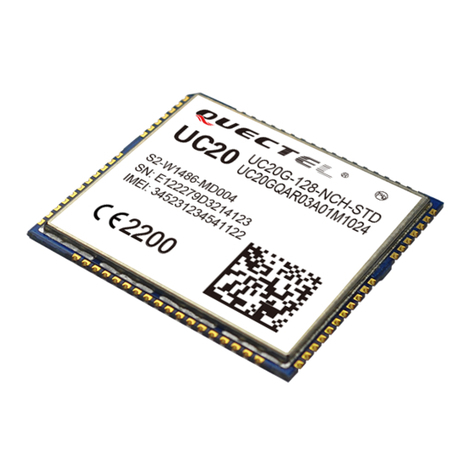
Quectel
Quectel UC20 user guide
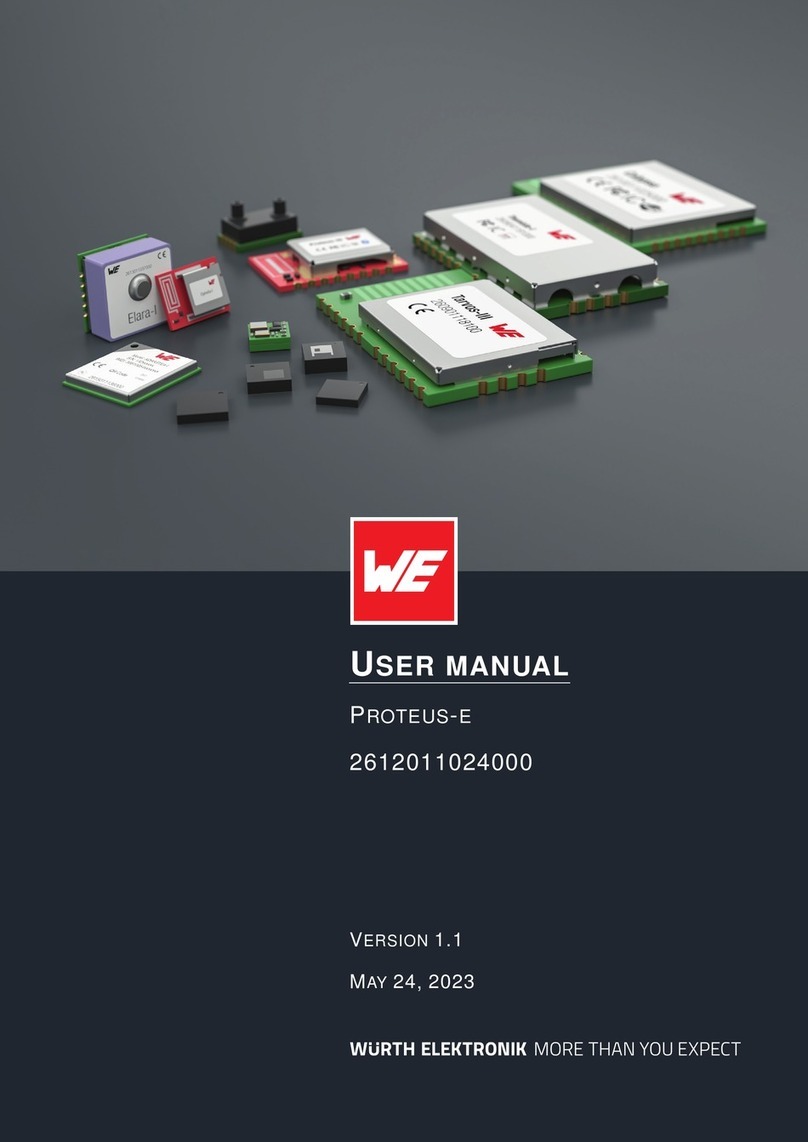
Wurth Elektronik
Wurth Elektronik Proteus-E user manual
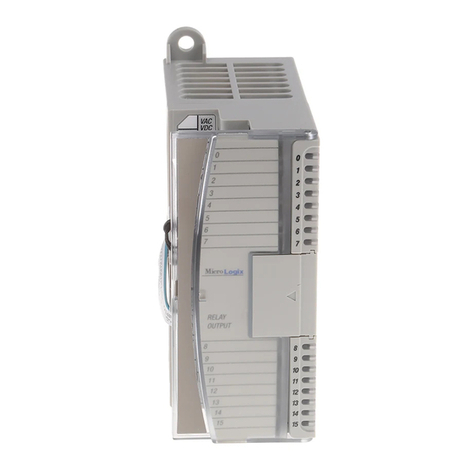
Rockwell Automation
Rockwell Automation Allen-Bradley MicroLogix 1762-OW16 installation instructions
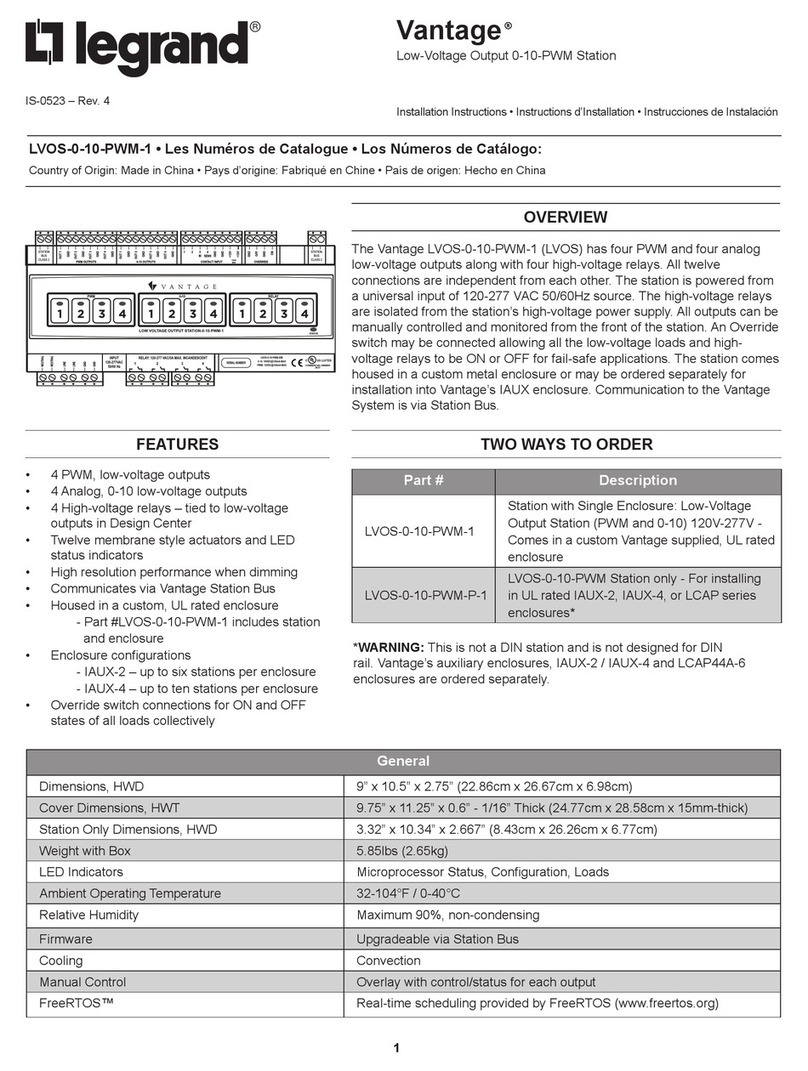
Vantage Hearth
Vantage Hearth LVOS-0-10-PWM-1 Installation
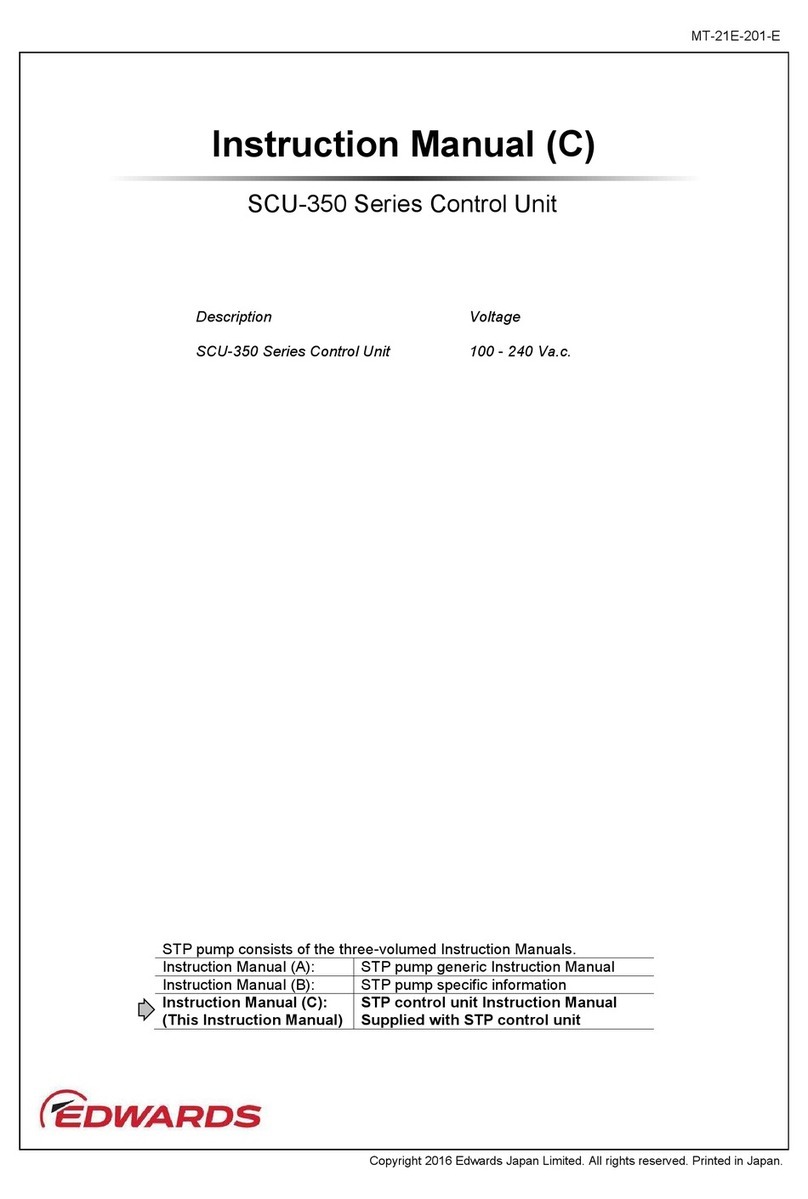
Edwards
Edwards SCU-350 Series instruction manual
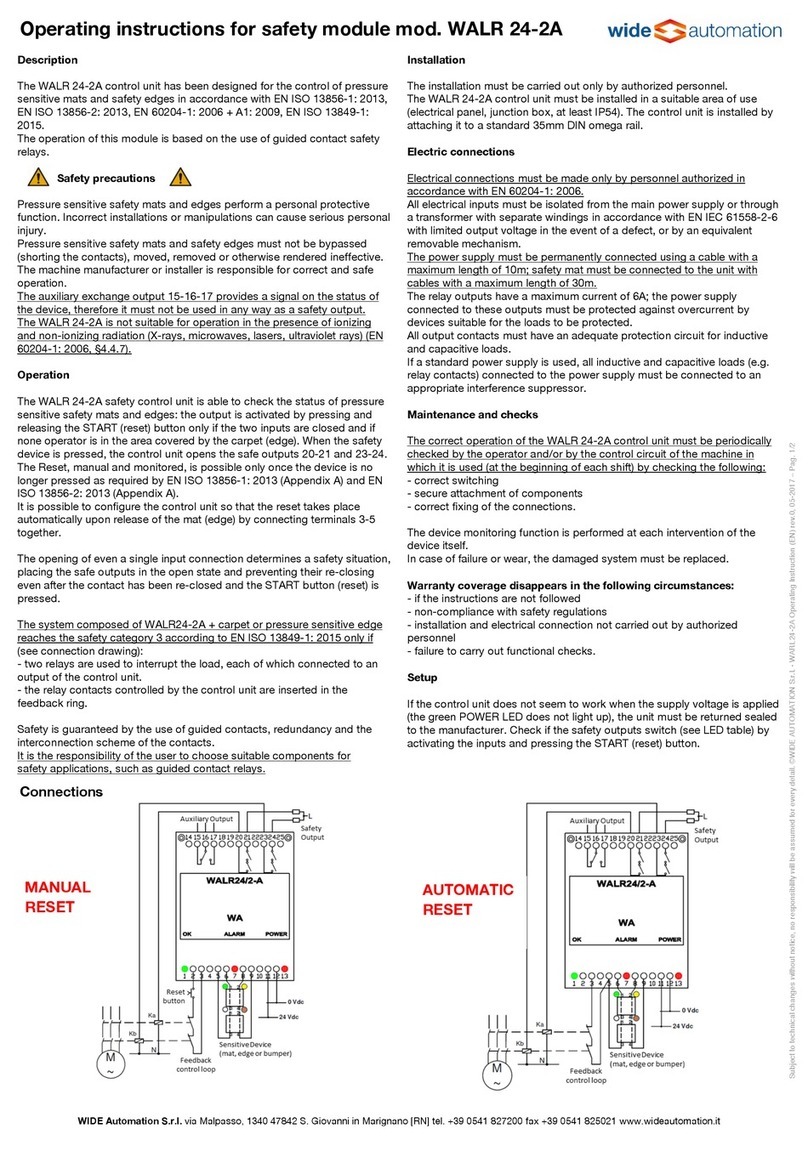
WIDE Automation
WIDE Automation WALR 24-2A operating instructions
